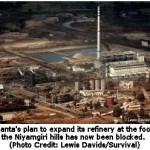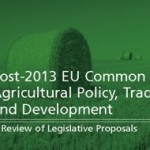 Billions of tons of carbon trapped in high-latitude permafrost may be released into the atmosphere by the end of this century as the Earth’s climate changes, further accelerating global warming, a new computer modeling study indicates.
Billions of tons of carbon trapped in high-latitude permafrost may be released into the atmosphere by the end of this century as the Earth’s climate changes, further accelerating global warming, a new computer modeling study indicates.
The study also found that soil in high-latitude regions could shift from being a sink to a source of carbon dioxide by the end of the 21st century as the soil warms in response to climate change.
The research was led by Charles Koven of the U.S. Department of Energy’s Lawrence Berkeley National Laboratory (Berkeley Lab). He conducted the research with a team of scientists from France, Canada, and the United Kingdom while he was a postdoctoral researcher at France’s Laboratoire des Sciences du Climat et de l’Environnement. The modeling was conducted at a supercomputing facility run by France’s Alternative Energies and Atomic Energy Commission.
Their study, titled “Permafrost Carbon-Climate Feedbacks Accelerate Global Warming”, was published on August 18 in online early edition of the ‘Proceedings of the National Academy of Sciences’.
Their findings counter results from a comparison of models that was included in the Intergovernmental Panel on Climate Change‘s 2007 Fourth Assessment Report. The comparison found that climate change will spark a growth in high-latitude vegetation, which will pull in more carbon from the atmosphere than thawing permafrost will release.
But unlike earlier models, the new model includes detailed processes of how carbon accumulates in high-latitude soil over millennia, and how it’s released as permafrost thaws. Because it includes these processes, the model begins with much more carbon in the soil than previous models. It also better represents the carbon’s vulnerability to decomposition as the soil warms.
As a result, the new model found that the increase in carbon uptake by more vegetation will be overshadowed by a much larger amount of carbon released into the atmosphere.
“Including permafrost processes turns out to be very important,” says Koven, who joined Berkeley Lab’s Earth Sciences Division as a staff scientist earlier this year. “Previous models tended to dramatically underestimate the amount of soil carbon at high latitudes because they lacked the processes of how carbon builds up in soil. Our model starts off with more carbon in the soil, so there is much more to lose with global warming.”
Koven and colleagues set out to estimate how much carbon dioxide and methane (which contains carbon) could be released by boreal and Arctic land ecosystems as a result of climate change. These regions are crucial to the global carbon cycle because they are rich in soil organic carbon, which has built up in frozen soils and peat layers over thousands of years.
Much of this carbon is presently trapped and not cycling. But scientists believe that some of it could be released in response to warming and become a positive feedback to global climate change. At stake is an estimated 2,167 petagrams of carbon in all layers of high-latitude soil, which is more than two trillion U.S. tons.
The scientists modified a land surface ecosystem model called ORCHIDEE to account for how carbon behaves at different layers, such as at the surface versus 30 centimeters below ground. They also accounted for the rate of soil carbon decomposition as a function of temperature at the freeze-thaw boundary, which sinks deeper and deeper as soil warms. Other improvements include soil physics that more realistically capture the effects of organic matter on carbon. Most other models do not have all of these phenomena.















